Many people choose to build muscle with push-ups because they have many benefits. Push-ups are one of the best bodyweight compound exercises for training the entire upper body.
And you’ve come to the right place if you are looking for push-ups that work the lower chest. Here, we’ll discuss the best push-ups for training the lower pec and how they work.
Unlike conventional push-ups, which target the entire chest area, lower chest push-ups emphasize the lower pec muscles by altering the body’s positioning (biomechanics).
They will help you strengthen and increase the thickness of your lower pecs. It will boost your explosiveness. Don’t believe me? Wait until you’ve worked your plyo push-ups to the flying progressions, and you’ll see what I mean!
Start with easy-to-do push-ups like incline push-ups, then build the muscle by gradually ramping up the reps, sets, or resistance, and include advanced push-up variations.
Let’s get started!
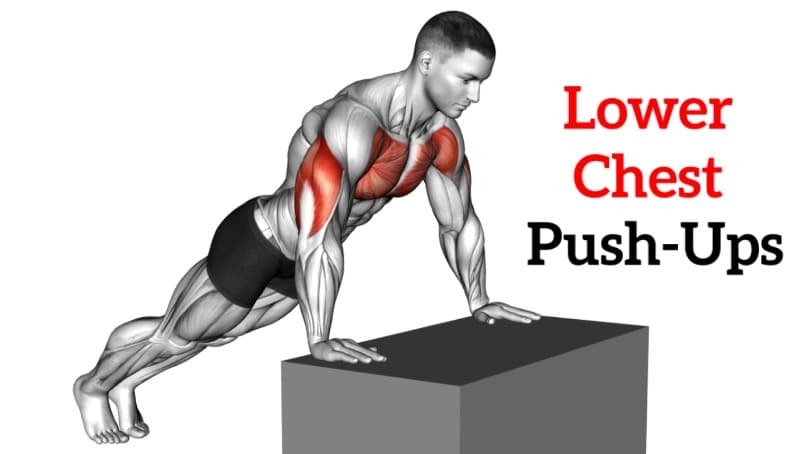
- Muscles Worked by Lower Chest Push-Ups
- 7 Best Push-ups That Work Lower Chest
- 1. Incline Push-Up
- 2. Elevated Push Up
- 3. Reverse Grip Push Up
- 4. Hindu Push-Up
- 5. Clapping Push Up
- 6. Medicine Ball Push-Up
- 7. Stability Ball Push Up
- FAQs
- Do incline push-ups work the lower chest
- Which push-ups work lower chest?
- How Can I Work Out My Lower Chest With Push Up?
- Takeaway
Muscles Worked by Lower Chest Push-Ups
Lower chest push-ups predominantly target the lower section of the pectoralis major, the chief muscle of the chest.
Several other muscles are engaged in addition to the pectorals. The anterior deltoid assists in the downward and upward motion of the push-up, and the triceps brachii extends the elbow during the rising phase and the serratus anterior.
Lastly, core muscles play a pivotal role in maintaining stability and form. These include the rectus abdominis, commonly known as the “six-pack” muscle; the obliques; and the transverse abdominis, a deeper muscle providing core stability.
In essence, while lower chest push-ups focus on the chest’s lower region, they offer a holistic workout for the upper body.
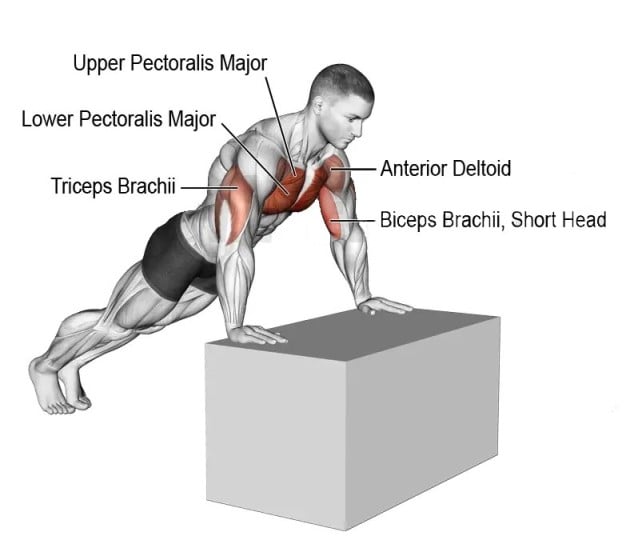
7 Best Push-ups That Work Lower Chest
Here are the best lower chest push that require no equipment or just a slight modification to target your lower pecs.
1. Incline Push-Up
The incline push-up is a great bodyweight exercise for building chest strength. It offers numerous benefits and is perfectly suited for both beginners and experienced athletes.
The incline push-up is a variation of the push-up in which you push yourself off from a raised object instead of the ground.
You can also use objects like a chair, a gym bench, a sofa, a box, a sturdy table, or anything else.
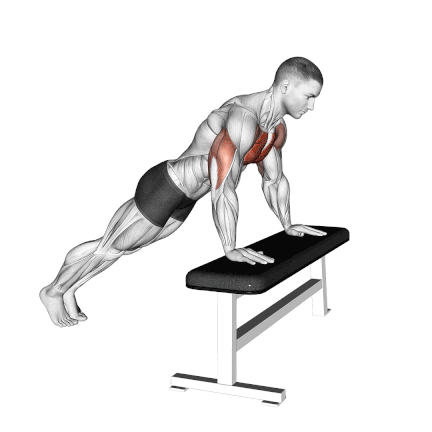
How To Do
- Stand approximately 3 to 3.5 feet away from a low bench or sturdy chair.
- Be sure the bench or chair is stable and secure before you perform the push-ups.
- Reach forward and grab the sides of the chair or in front of the bench.
- Slowly lower yourself by flexing your elbows so that your chest comes within a few inches of the edge of the chair or bench.
- Push yourself back to the starting position while keeping your body straight from head to ankle.
- The movement should be smooth and controlled.
2. Elevated Push Up
The higher you are, the easier the push-up, while the lower you are, the more challenging it is. This move works the chest, shoulder, and triceps, and the slight incline will work the lower chest more than standard push-ups.
Push-ups can be performed with many variations to create different muscular recruitment patterns. Performing push-ups at an incline angle will focus more on the lower chest.
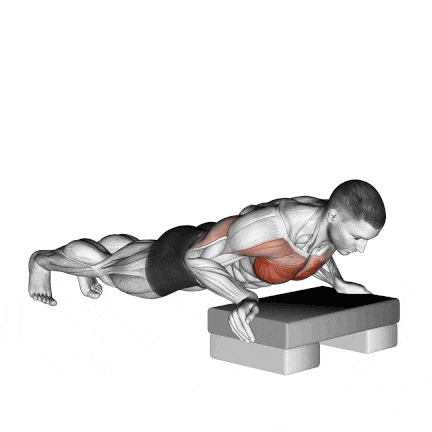
How To Do
- Put the hands, shoulder-width apart, on the bricks.
- Adopt an incline plank position by extending the legs backward until the legs and back form a straight line.
- Slowly bend the arms to lower the chest toward the bench. Remember to keep the elbows and arms close to the body.
- Slowly push the body away from the bench, extending the arms but maintaining a slight bend in the elbow.
- Perform 8–12 reps for one set.
3. Reverse Grip Push Up
The reverse grip push-up is a fun and great variation of the standard push-up. You do it with your fingers facing your feet (your palms outward).
These push-ups require your hands to be closer to the hips beneath the lower chest level. This makes your lower chest and front shoulders work extra hard during the movement.
Reverse grip push-ups may be somewhat uncomfortable for those more familiar with conventional push-ups.
One good way to set up the exercise is to elevate the palms with a small object, reducing the distance the wrists need to bend at full depth.
You should always do a proper warm-up, focusing on warming up and stretching your wrists.
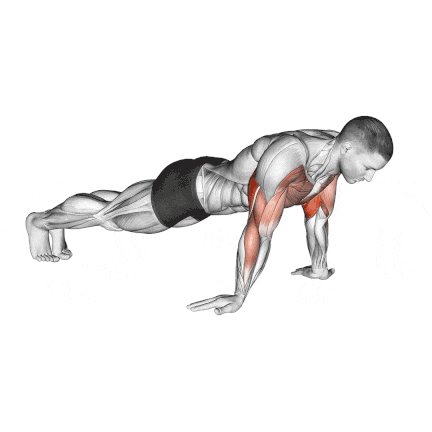
How To Do
- Get into a press-up position and point your fingers at your toes.
- Keep your neck in a neutral position to avoid stressing and hurting it.
- Take a big breath in and slowly start to bend your elbows.
- Do not let your elbows move outwards (away from your body).
- Lower yourself until you are about an inch from the floor. When you are at the bottom, pause the movement for a second.
- Push through your palms like you would try to push the floor away from yourself, extending the arms but maintaining a slight bend in the elbow.
- Repeat this for however many repetitions you wish to perform.
4. Hindu Push-Up
The Hindu push-up is a traditional Indian-style exercise practised by wrestlers. Each repetition involves going from a downward dog position to a cobra pose and swooping by holding the head and body close to the ground.
The arms would be straight at the exercise’s beginning and end. This variety of push-ups has existed for centuries among Indian martial artists. It works on core strength, shoulders, hips, and triceps.
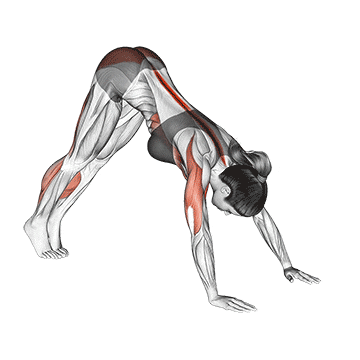
How To Do
- Start in a downward dog pose, with your hands shoulder-width apart, your body in a V shape, and your feet hip-width apart.
- Bend your elbows and lower your chest until it’s just above the floor, going into low plank pose.
- In a scooping motion, scoop your head upward while arching your lower and upper back and go into cobra pose.
- To complete the move, you need to return to the starting position.
- Slowly lower your stomach and lift your hips, push them back and engage your core and glutes.
- Now, repeat. Do 8-12 repetitions in a set, with the aim of completing 3-4 sets per workout day.
- If you find it tough to do 8-12 repetitions, start with 3-5 repetitions in a set and slowly increase your strength to do more repetitions.
5. Clapping Push Up
Clap push-ups are a powerful exercise for anyone looking to boost their upper body strength and explosiveness, especially those just starting more advanced bodyweight training.
When you lower yourself into a push-up and then explode upwards, clapping your hands mid-air, you’re using something called the stretch-shortening cycle (SSC). This means you’re quickly switching from an eccentric (lowering) phase to a concentric (pushing) phase, which helps build explosive strength in your chest, shoulders, and triceps.
Think of it like loading a spring—the faster you load and release, the more power you generate.
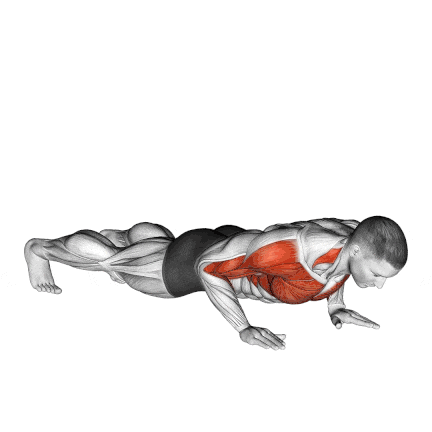
How To Do
- Start with a standard push-up. Keep the core tight and back neutral.
- Lower your body as if you’re going to do a push until your chest is almost touching the floor.
- Reverse the motion by pushing hard through the palms just as your arms reach full extension. Then, pull your hands up from the floor.
- Rapidly clap your hands together and return them to their original position before your body falls to the ground.
- Be sure to exhale when exploding off the ground and inhaling on the way down.
6. Medicine Ball Push-Up
It is more challenging than the basic push-up. This bodyweight exercise is similar to the diamond push-up. The medicine ball, however, does provide a form advantage. Along with tricep, it also helps improve core strength and stability.
Do not attempt medicine ball pushups until you can do 20 basic pushups. For an easier variation, you could do them with your knees bent on the floor.
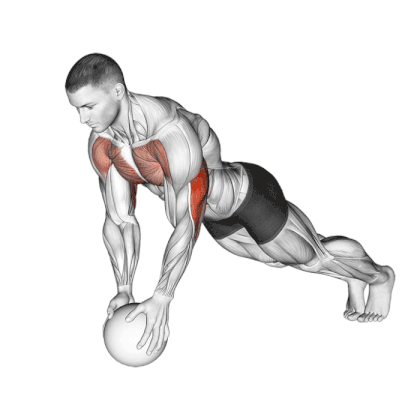
How To Do
- Get in the standard push-up position with your hands on a medicine ball directly beneath your chest.
- Your left thumb and forefinger should touch your right thumb and forefinger.
- Bend your elbows to lower yourself in a controlled manner.
- Maintain a rigid core as your chest moves toward the top of the ball.
- Hold for one to two seconds before breathing out, extending your arms, and pushing your body back to the starting position.
7. Stability Ball Push Up
Using a stability ball can make push-ups more difficult by giving you an uneven surface to work with. However, this is a great exercise for working the lower part of the chest. The instability of the Swiss ball forces your core and triceps to work overtime to maintain control.
You must work harder to maintain your balance on the ball, making the move more challenging than the standard, floor-based version.
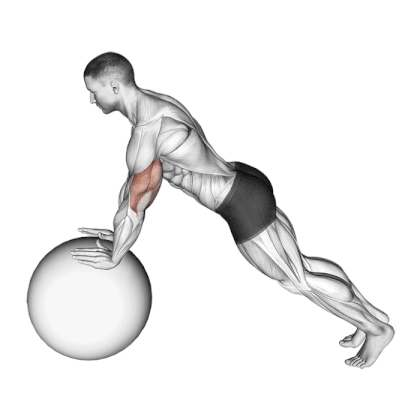
How To Do
- Lay on the stability ball with your chest on it. Place your hands on the ball at the sides of your chest, shoulder-width apart.
- Place your feet back and lean forward so that your chest is directly over the ball, and you are supported on your toes.
- Do not let your lower back sag or your butt rise. Ensure your body is straight and rigid. K
- Push your body up, until your arms are almost straight (do not lock your elbows). Pause here for a second.
- Breathe out and extend your arms to bring your upper body back to the starting position.
FAQs
Do incline push-ups work the lower chest
Incline Push-Ups are the best exercises for training the lower chest.
Which push-ups work lower chest?
The incline push-up is one of the best pushups for the lower chest. You must incline at a certain angle to complete this move. The inclination is what helps target the lower chest muscles.
How Can I Work Out My Lower Chest With Push Up?
Several different push-up variations are available. You will need to modify the exercises when you do them at home, but you can get a good workout without expensive fitness equipment.
Instead of push-ups on a gym bench, you could use chairs or any other elevated surface. You could also do incline push-ups on a sofa or chair.
You can be more creative once you learn how to make basic changes.
Takeaway
It can be difficult to train parts of the body that are particularly stubborn, but with persistence, the right methods, and slight modifications to push-up exercises, you might be able to make a positive change.
The push-ups above will work the lower chest when a person performs them correctly. Adding these exercises to a full-body strength training routine is best to achieve a well-balanced physique.
To build a strong upper body, it’s important to train the chest as a whole unit and then focus on getting all 3 parts of the muscle working.

Manish is a NASM-certified fitness and nutrition coach with over 10 years of experience in weight lifting and fat loss fitness coaching. He specializes in gym-based training and has a lot of knowledge about exercise, lifting technique, biomechanics, and more.
Through “Fit Life Regime,” he generously shares the insights he’s gained over a decade in the field. His goal is to equip others with the knowledge to start their own fitness journey.

